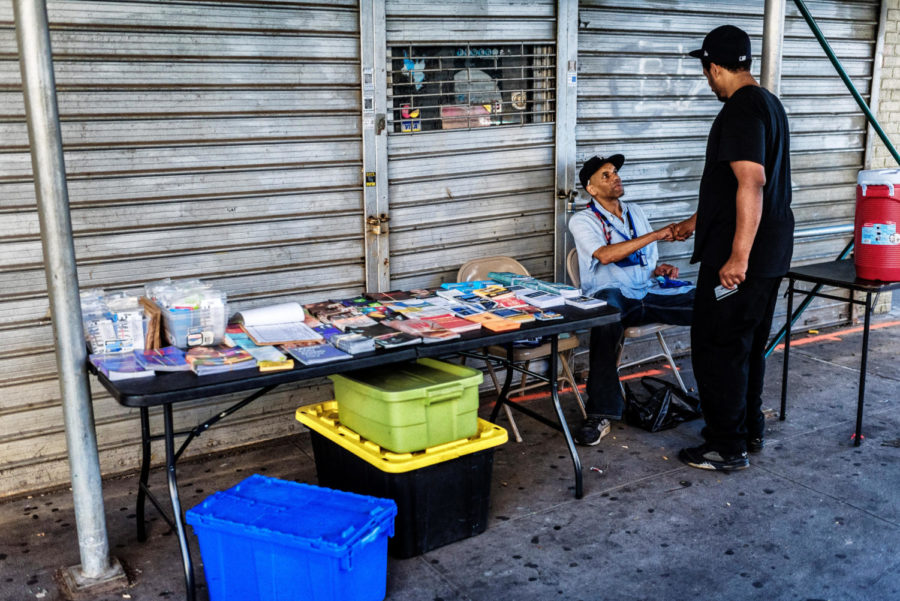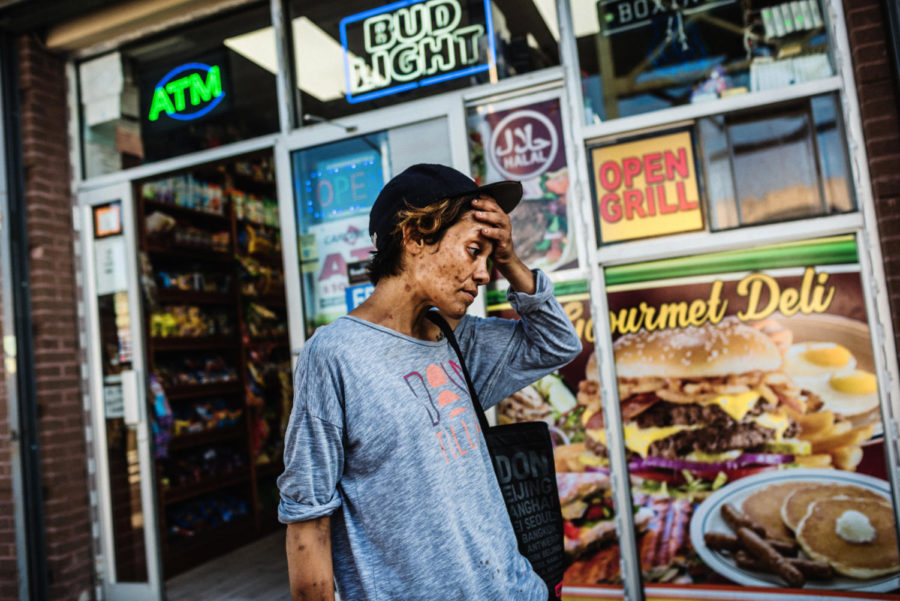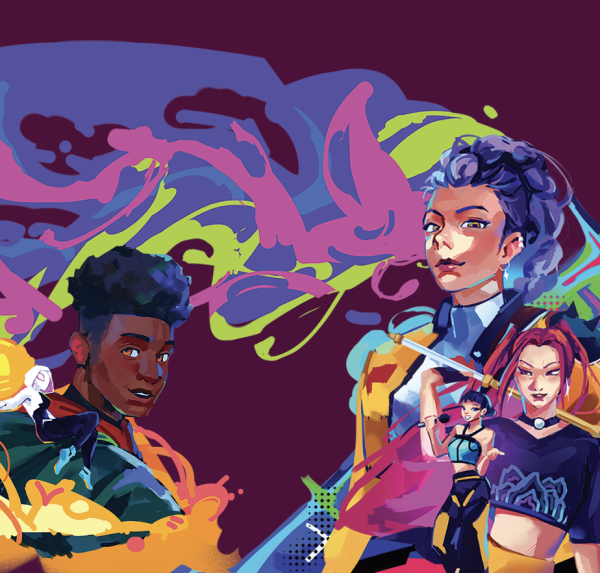The Face of Crisis
The opioid epidemic affects millions of Americans on a growing scale. Many artists have set out to capture the candid vulnerability of addiction both in use and recovery. Their efforts serve to humanize and highlight addiction’s impact on countless lives and to provide momentum behind policies aimed at effectively relieving the crisis.
Ryan Christopher Jones/American Reportage
Jackie outside of a bodega in the Bronx after shooting heroin. Her friend, Kelly, stayed with her for approximately thirty minutes to make sure she was safe while high.
The likelihood of death by drug overdose has now outrun that of vehicular accidents. Opioid use disorder, the physical and psychological dependence on addictive opioids, has now become a reality that many Americans face. Although calling urgency to this national epidemic has pushed the government towards enacting policies to solve this crisis, the humanization and respect for the individuals who experience addiction is often lost. Drug addiction is a brain disorder characterized by repeated, compulsive substance abuse. This definition, however, can be lost through certain portrayals of drug addiction as a choice. Through exaggerated depictions of teenage drug use in party culture or interactions with the police and courts, substance abuse is associated with crime and wrongdoing rather than with vulnerability and recovery. These misrepresentations often manifest in the media, but filmmakers, photographers and writers alike seek to redefine these depictions through their art.
In much of the media, individuals who experience addiction are shown in intensely vulnerable and compromising positions—with needles in their arms, shivering on the floor or overdosing. These jarring and sometimes gruesome images contribute to the disrespectful narrative that may harm this crisis more than help it. As addiction becomes an increasingly common story in America, activists push for a change in the narrative. Maia Szalavitz, author of “Unbroken Brain,” emphasizes that addiction should be viewed as an illness to improve treatment and prevention. Repeatedly abusing a certain substance can lead to addiction — physical dependence on a certain substance. “Most of the images we see of addiction are dehumanizing, making it seem as though people with addiction are zombies or aliens,” Szalavitz said. “These images often involve interactions with police or courts, which emphasizes the idea that addiction is a crime, not a disease.” Yet, by responsibly showing the entire story of drug use, the media has the potential to improve how addiction is understood and how to treat it effectively.

Journalist Zachary Siegel, who reports about public health and criminal justice in the context of drugs, explains the importance of responsibly telling the entire story of drug use. “In my reporting, I don’t use the word addict to identify anybody,” Siegel said. By placing labels on people who experience drug addiction, the story of this illness is altered to pigeonhole people into one role. Because of this, the public only sees a slice of a person, classifying them solely as someone who is addicted to drugs. “It erases someone’s humanity,” Siegel said. “People are people, and they are more than their illnesses.”
The film “Beautiful Boy” depicts drug addiction past the close-minded narratives that the public is used to seeing. Instead of glamorizing addiction through the typical stereotypes associated with teenage drug abuse, “Beautiful Boy” presents the changing father-son relationship that is affected by the cycle of addiction and sobriety. The film provides a raw look into addiction, emphasizing that “relapse is a part of recovery.” The film contradicts the stereotypes that those who are addicted to drugs are involved in an unhealthy party culture, uneducated or living in poverty. Based on a pair of memoirs surrounding the main character, Nic Sheff, and his experience with addiction, “Beautiful Boy” elucidates that addiction can affect individuals within any income, race or education level.
“What ‘Beautiful Boy’ did well is show that addiction isn’t about partying and hedonism; it’s about someone like Nic Sheff who has a mental health condition,” Siegel said. “He was diagnosed with bipolar and drug use for him was a way to cope with internal and psychological pain.” Oftentimes, the reason why people begin using drugs is not depicted, with the media instead opting to show addiction as a result of ignorant choices. Most often, the real reasons behind addiction are not obvious to others and vary between individuals. Understanding this can transform the methods of addiction prevention and treatment. “Addiction for most people is not a party, it’s not fun, and few people wake up in the morning and choose to become addicted to a drug,” Siegel said. “It’s a very lonely and isolating and painful experience.”
There is a similar sentiment in portraying the opioid epidemic through photography. Through his work, photojournalist Ryan Christopher Jones captures the scale of the opioid epidemic and presents its reach past the commonly-known, heavily impacted areas in the rural Midwest. Jones covers the New York City opioid crisis by taking photos of the epidemic in the Bronx, which is an area that is second behind the state of West Virginia in overdoses. When covering this epidemic, Jones makes a point not to take images of people actively using drugs. Rather than fixating on the actual drug use itself, Jones strives to show the bigger picture of how the opioid crisis affects people’s lifestyles and personal relationships.
“The opioid epidemic really affects everyone,” Jones said. “If so many people are experiencing addiction, and each of those have around 25 people who are trying to support them or get them into rehab, then it really does touch almost everyone in the country.” Because of this, it is important that the public is well informed about addiction and overdose in order to help and support those who are experiencing addiction. “I always carry Narcan [used to stop overdose] with me when I go out on assignments like this,” Jones said. “I just think that if I come across someone who could be overdosing that I will be able to help them out because it’s just the right thing to do.”

Providing a platform for the youth to understand addiction, Jarrett Krosoczka’s autobiographical graphic novel “Hey, Kiddo” depicts his childhood struggle dealing with his mother’s absence due to her heroin addiction, through images of empty graduation halls and a full voice mail box. Writing “Hey, Kiddo” with the intent to help children in similar situations, Krosoczka conveys his confusion and cluelessness as a child, coupled with his adolescent frustration upon learning of his mother’s addiction. Throughout the novel, Krosoczka never blames his mother, Leslie, for her addiction or absence, instead regarding her with empathy and support. “Leslie knew that I was writing a memoir and expressed hope that perhaps our story could help somebody who might be walking a similar path to the one we had walked,” Krosoczka said. “I so wish that she could be holding this finished book and turning the pages.”
Drug use as depicted through literature is continuing to take on a more first-person perspective to provide a candid view into addiction. Recently deemed the “first great novel of the opioid epidemic,” “Cherry” is a beautiful paradigm for a genuinely bitter and raw narrative of addiction. Drawing heavily from veteran and author Nico Walker’s life experiences, “Cherry” gives a forthright voice to many returned soldiers who have fallen into the grasps of addiction. The novel follows a young, unnamed man as he attempts to escape his seemingly meaningless life in Cleveland, Ohio, to serve as a medic in the military. After facing the harsh truth of death, he returns with a life which is now only given meaning through one thing: heroin. Through the author’s ever-increasing vulnerability to the demon of addiction, the reader is left wanting to address not only his suffering but all of the individuals also swept up by the crisis. The story was written on a typewriter during Walker’s 11-year prison sentence and relays many crucial realities through this primary voice. By upholding literature that elevates such voices and serves to humanize such a widespread problem, messages of respect and call to action reached the thousands of readers who purchase the best seller.
As many seek to transform the narrative of drug addiction and give the proper respect to those affected by it, the use of art and modern platforms allow the spread of this positive message. “If we want to improve understanding of addiction, we have to start covering it the way would we cover any other illness and that means respecting people’s dignity and not focusing on them at their worst,” Szalavitz said. “If we want to destigmatize addiction, we have to have the same respect for people who suffer from it.”

Paly Junior, Raj Sodhi, joined the publication because he was attracted to the design and subject matter of the articles. He loves the committee of C...










